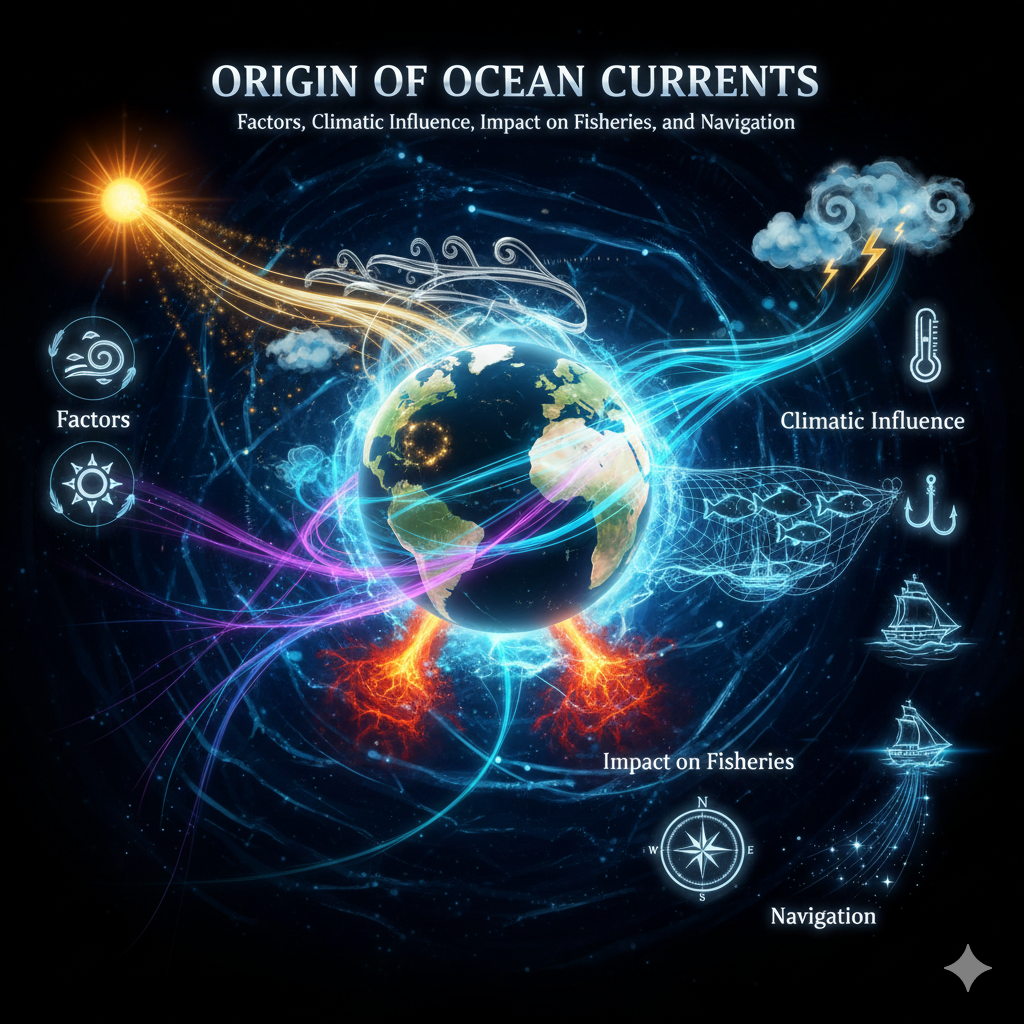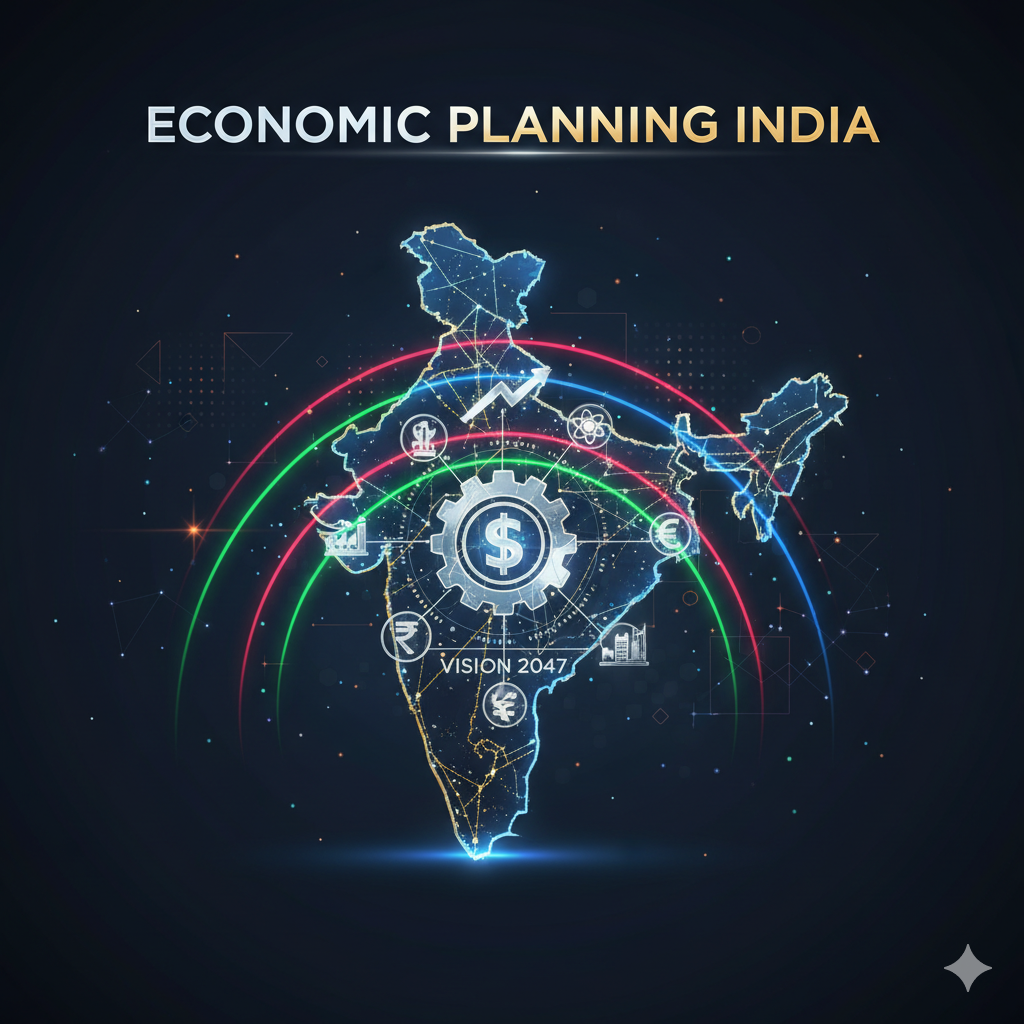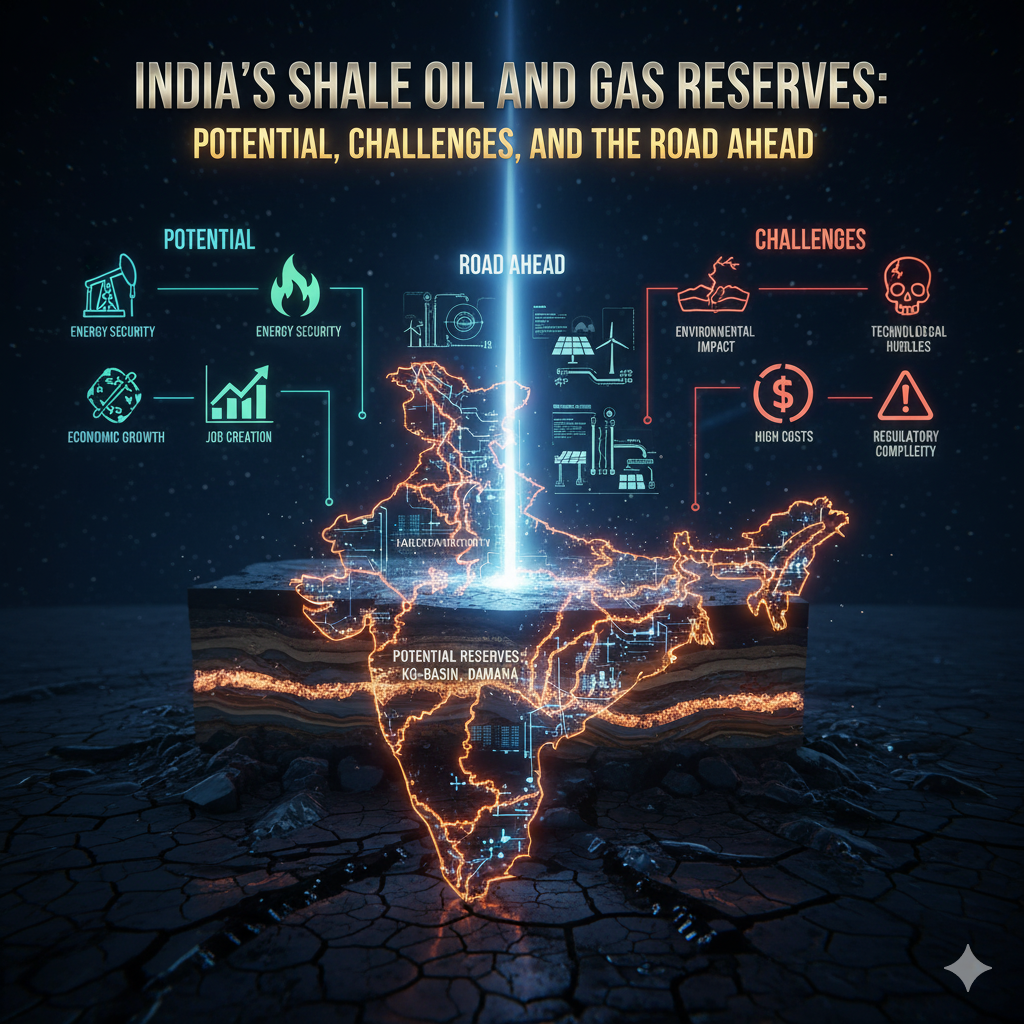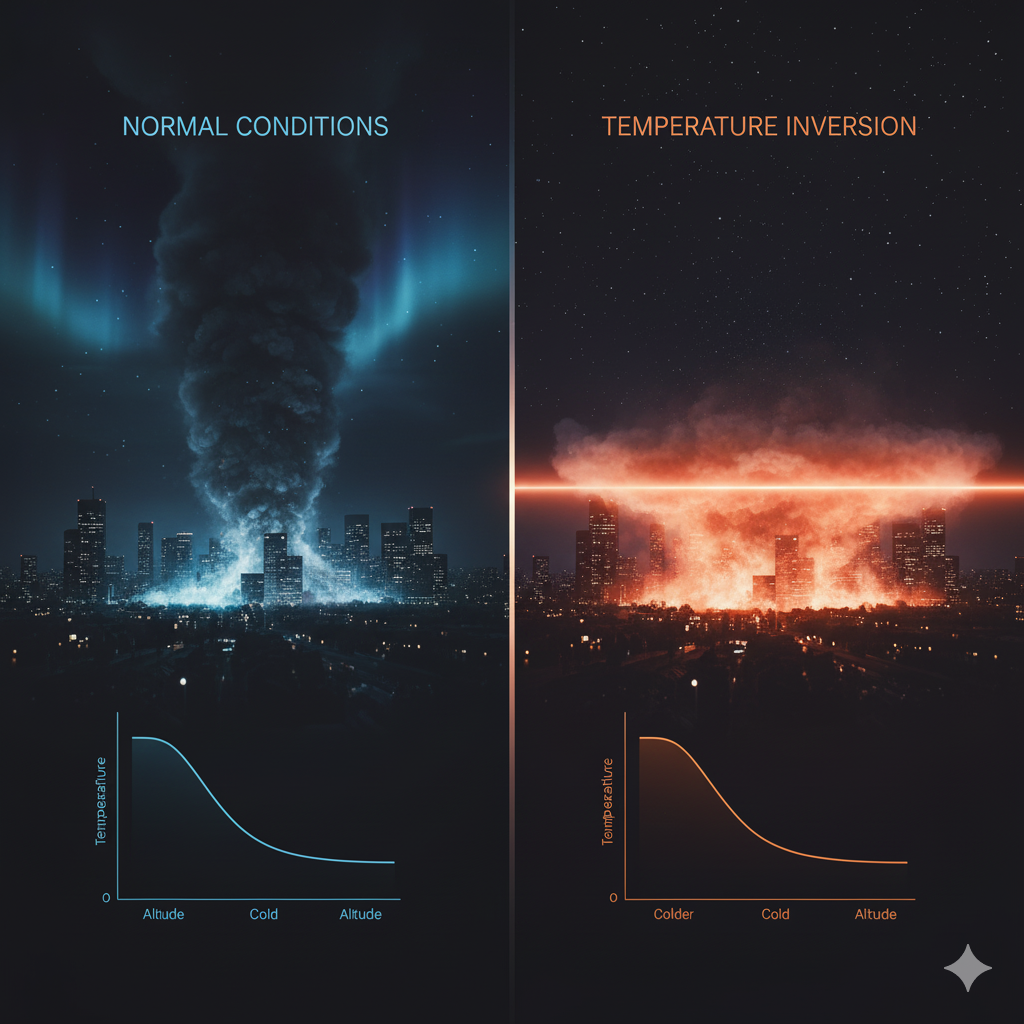Introduction
Oceans cover nearly 71% of the Earth’s surface and act as vast reservoirs of energy, nutrients, and biodiversity. The waters of the oceans are never static; they are constantly moving in well-defined patterns known as ocean currents. Ocean currents are large-scale horizontal flows of water within the oceans, influenced by a combination of natural factors such as wind, the Earth’s rotation, salinity, density differences, and the shape of coastlines. These currents play an indispensable role in regulating global climate systems, supporting marine life, and enabling human activities such as fishing and navigation.
Understanding the causes behind the origin of ocean currents and their impacts is vital not only for physical geography but also for human survival, as climate regulation, food security, and international trade are deeply tied to them.
Factors Responsible for the Origin of Ocean Currents
The origin of ocean currents is a result of a complex interplay of physical, chemical, and geological factors. The following are the major forces:
1. Wind Systems
- Trade Winds: The easterly trade winds in tropical regions push surface waters westward, creating equatorial currents like the North and South Equatorial Currents.
- Westerlies: In the temperate zones, westerly winds drive ocean waters eastward, giving rise to currents like the North Atlantic Drift and the Kuroshio Current.
- Wind acts as the primary driving force for surface currents, transferring energy to the ocean through frictional drag.
2. Coriolis Force (Effect of Earth’s Rotation)
- The Earth’s rotation deflects moving water masses, leading to clockwise circulation in the Northern Hemisphere and counter-clockwise in the Southern Hemisphere.
- For example, the Gulf Stream bends eastward towards Europe due to the Coriolis effect.
- Without the Coriolis force, currents would simply follow the direction of prevailing winds.
3. Differences in Temperature and Density
- Temperature affects water density: warm water is lighter and rises, while cold water is denser and sinks.
- This creates vertical circulation (thermohaline circulation) which forms deep ocean currents.
- Polar regions, where water is cold and salty due to ice formation, are major sites for dense water sinking, driving global conveyor belt circulation.
4. Salinity Differences
- Salinity affects water density: higher salinity makes water denser.
- For example, the Mediterranean Sea has highly saline waters, which flow into the Atlantic and sink, influencing circulation in that region.
- Similarly, areas of heavy rainfall or river discharge reduce salinity and density, modifying current flow.
5. Configuration of Coastlines and Ocean Basins
- Landmasses act as barriers, deflecting currents into circular gyres.
- For example, the clockwise North Atlantic gyre is formed by the Gulf Stream, North Atlantic Drift, Canary Current, and North Equatorial Current, constrained by surrounding continents.
- Narrow straits and continental shelves also modify current strength and direction.
6. Seasonal Variations
- In monsoon regions, seasonal wind reversals affect currents significantly.
- Example: In the Indian Ocean, the Southwest Monsoon Current flows eastward during summer, while the Northeast Monsoon Current reverses direction in winter.
7. Upwelling and Downwelling Forces
- When winds blow parallel to coastlines, surface waters move away (due to the Coriolis effect), causing nutrient-rich deeper waters to rise — a process known as upwelling.
- Downwelling occurs where surface waters converge and sink, transporting oxygen-rich water to deeper layers.
8. Gravitational Forces of the Moon and Sun
- Though tides are periodic, tidal forces also influence the mixing of water masses, especially in shallow seas and coastal regions, indirectly affecting local currents.
9. Human Activities (Secondary Factor)
- Artificial structures like dams and canals alter freshwater input into oceans, affecting salinity and local current patterns.
- Climate change, driven by humans, is modifying temperature and ice melt patterns, altering deep-water circulation.
Types of Ocean Currents
Understanding the nature of currents helps explain their influence:
- Warm Currents – Flow from equatorial regions towards poles (e.g., Gulf Stream, Kuroshio Current).
- Cold Currents – Flow from polar regions towards the equator (e.g., Humboldt Current, Labrador Current).
- Surface Currents – Driven mainly by wind and confined to upper layers.
- Deep Ocean Currents – Driven by density and salinity differences, forming global thermohaline circulation.
Influence of Ocean Currents on Regional Climates
Ocean currents act as conveyors of heat and moisture, influencing weather and climate systems worldwide.
1. Moderation of Climate
- Warm currents raise temperatures of adjacent coastal regions.
- Example: The Gulf Stream keeps Western Europe warmer than other regions at similar latitudes.
- Example: The Gulf Stream keeps Western Europe warmer than other regions at similar latitudes.
- Cold currents cool down nearby coastal areas.
- Example: The Peru Current makes the west coast of South America cooler and drier.
2. Rainfall Distribution
- Warm currents promote evaporation and increase precipitation.
- Example: The Kuroshio Current contributes to the humid climate of Japan.
- Example: The Kuroshio Current contributes to the humid climate of Japan.
- Cold currents suppress cloud formation and reduce rainfall.
- Example: The cold Benguela Current off southwest Africa creates desert conditions in the Namib Desert.
3. Formation of Deserts
- Cold currents along western continental margins are linked to deserts such as:
- Atacama Desert (Peru Current).
- Namib Desert (Benguela Current).
- Kalahari Desert (Canary Current).
4. Monsoon Modulation
- Indian Ocean currents influenced by monsoons directly impact rainfall in South Asia.
- Failure of monsoon-related currents can disturb agricultural productivity.
5. Cyclone Formation
- Warm currents provide latent heat energy for tropical cyclones.
- For example, hurricanes in the Atlantic intensify when moving over the Gulf Stream.
6. Global Heat Redistribution
- Currents act as global heat transporters, transferring excess heat from the equator to poles.
- Without them, equatorial regions would be unbearably hot and polar regions even colder.
Influence of Ocean Currents on Fishing
Fishing communities worldwide are heavily dependent on current systems for abundant marine life.
1. Upwelling and Nutrient Supply
- Upwelling currents bring nutrient-rich cold water to the surface, supporting plankton growth and fish populations.
- Example: The Peru (Humboldt) Current supports one of the richest fishing grounds in the world.
- The Benguela Current supports sardine and anchovy fisheries off Namibia.
- Example: The Peru (Humboldt) Current supports one of the richest fishing grounds in the world.
2. Migration of Fish
- Many fish species migrate along currents, enabling seasonal fishing.
- Example: Tuna and salmon migration is guided by warm and cold current systems.
3. Impact of El Niño and La Niña
- During El Niño, warm waters replace nutrient-rich cold currents off Peru, causing a collapse in fisheries.
- La Niña strengthens cold currents, improving fish catch.
4. Coastal Community Livelihoods
- Millions of fishermen depend on current-driven fishing zones.
- Overfishing in upwelling zones has economic consequences worldwide.
Influence of Ocean Currents on Navigation
Historically and in modern times, ocean currents have been critical in navigation and global trade.
1. Assistance in Sea Voyages
- Sailors in the Age of Exploration used currents like the North Equatorial Current and Gulf Stream to cross the Atlantic.
- Portuguese explorers used the Canary Current and trade winds to reach Africa and South America.
2. Energy and Time Efficiency
- Ships traveling with favorable currents consume less fuel and time.
- For example, traveling from Europe to North America is quicker using the Gulf Stream drift.
3. Hazards in Navigation
- Cold and warm current convergence zones create fog, storms, and turbulence, endangering ships.
- Example: The meeting of the Gulf Stream and Labrador Current near Newfoundland creates thick fog, hazardous for navigation.
4. Modern Shipping and Naval Strategy
- Currents are now mapped precisely for trade routes and naval maneuvers.
- Submarines also use deep currents for stealth movement.
Case Studies
1. Gulf Stream and Europe’s Climate
Without the Gulf Stream, Western Europe would experience much harsher winters similar to Siberia, despite being at the same latitude.
2. Peru Current and Atacama Desert
The cold Peru Current prevents rainfall along Chile’s coast, giving rise to the driest desert on Earth.
3. El Niño and Global Impact
Every few years, El Niño disrupts fisheries in Peru, brings drought in India, and floods in the Americas — highlighting the global reach of current systems.
Challenges in Understanding and Predicting Ocean Currents
- Climate Change: Melting polar ice is altering salinity and disrupting thermohaline circulation.
- El Niño Southern Oscillation (ENSO): Its irregular pattern complicates long-term predictions.
- Marine Pollution: Oil spills and plastics are carried across oceans by currents, spreading environmental hazards.
- Overfishing in Current Zones: Exploiting nutrient-rich zones threatens ecological balance.
Conclusion
Ocean currents are the lifelines of the Earth’s climatic system and marine ecology. Their origin lies in the complex interactions of wind systems, Earth’s rotation, salinity, temperature, and landmass configuration. They influence regional climates by moderating temperatures, distributing rainfall, and shaping deserts. They sustain some of the richest fisheries through upwelling zones, directly impacting food security and livelihoods. Furthermore, they have historically guided navigation and continue to shape modern maritime trade and naval strategies.
In an era of climate change and global interdependence, understanding ocean currents is more crucial than ever. They are not merely physical phenomena but fundamental regulators of Earth’s environmental balance, human sustenance, and economic prosperity.




